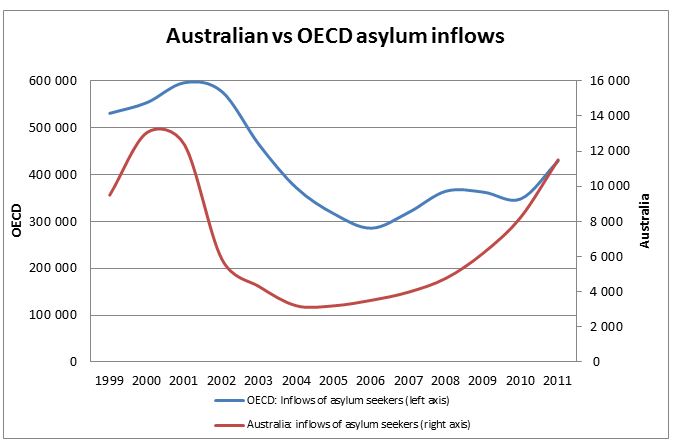The Flow of Asylum Seekers to Australia follows world trends. John Menadue
March 22, 2013
The Australian Parliamentary Library has just released a Research Paper showing that the flow of asylum seekers to Australia since 1999 follows the trends of asylum flows to OECD countries generally.
Reading the Australian media one would think that we have a problem with asylum seekers that no other country has.
At the Centre for Policy Development, in a report we issued in April 2011, we pointed out that the trend of asylum seekers to OECD countries, including Australia, showed that civil unrest and persecution in source countries are the major influences in asylum movements around the world and far more influential than the deterrent policies of any one destination country including countries like Australia.(p 32)
That assessment has been confirmed by the Research Paper by the Australian Parliamentary Library dated 11 February 2013, Asylum seekers and refugees. What are the Facts? The Canberra Press Gallery is so absorbed in polls and politics, it has yet to read this important document which is right under its nose.
The APL report says Although Australias global share of asylum applications is small compared to many other OECD countries, in terms of fluctuations in asylum applications, the trend since 1999 reflects similar patterns. (The figures are 1999-2011. 2012 figures are not yet available.)
The chart below shows clearly that the pattern of flows is similar for Australia and OECD countries.
APL has drawn data from OECD,International Migration Outlook 2012 and the OECD website, Inflows of Asylum Seekers
The Coalition and Tony Abbott continue to cite the decline in boat people after the Howard Government introduced the Pacific Solution in 2001. But what is important is the total number of asylum seekers coming to Australia and other countries and not their mode of arrival. Boat arrivals did largely stop after 2001, but air arrivals continued at about 4,000 p.a.
What the chart shows is that the decline in overall asylum seeker numbers coming to Australia after 2001 was very similar to the decline elsewhere. The number of asylum seekers going to OECD countries roughtly halved from 2001 to 2006. In the same period the number of asylum seekers coming to Australia also roughly halved.
The number of asylum seekers seeking refuge in all countries, including Australia, began to rise again in 2006. This was due to the state of emergency that was declared in Sri Lanka in 2005 and the US troop surge in Iraq in 2007. In 2008, the Sri Lankan Government withdrew from a ceasefire with the Tamil Tigers and in Afghanistan, the Taliban rejected peace talks. The figures in the APL chart show that in broad terms asylum seekers seeking refuge in OECD countries has been similar to the trends we have seen in Australia since 2006 . It was not due to changes in refugee and asylum policies by the Rudd Government.
Obviously in comparing trends there will be some differences in leads and lags. There will also be variations due to the location of the persecution and conflict. For example Australia is more likely to be affected by persecution in our region, eg in Sri Lanka or Myanmar, rather than events in the Middle East which are likely to affect Europe much more.
The APL Research Paper shows that the driver of asylum seeker numbers are the push factors war and persecution and not the deterrent policies such as the Pacific Solution that we mistakenly are told was responsible for the changes in numbers seeking asylum in Australia.
The APL Research Report nails the propaganda which is carried by the media that Australia has a particular problem with asylum seekers. The problems we face are similar to those of the OECD as a whole. Furthermore the number coming to Australia is small by comparison with many other countries.
John Menadue

